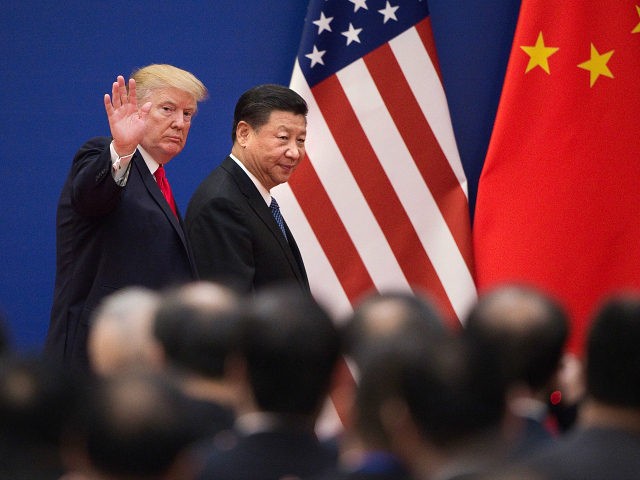WASHINGTON, DC — China’s “impressive military buildup” may soon enable the People’s Liberation Army (PLA) to challenge America’s military dominance in the Indo-Pacific region “across almost all domains,” Adm. Harry Harris, the chief of U.S. Pacific Command (USPACOM) cautioned lawmakers on Wednesday.
During a hearing Wednesday, Adm. Harris told the House Armed Services Committee via written testimony on China:
China’s historically unprecedented economic development has enabled an impressive military buildup that could soon challenge the U.S. across almost all domains. Key Chinese advancements include: significant improvements in missile systems; 5th generation fighter aircraft capabilities; and increased size and capability of the Chinese navy. A major initiative for that growing navy is China’s first-ever overseas base in [the African country of] Djibouti.
I am also deeply concerned about China’s heavy investments into the next wave of military technologies, including hypersonic missiles, advanced space, and cyber capabilities, and artificial intelligence – if the U.S. does not keep pace, USPACOM will struggle to compete with the People’s Liberation Army (PLA) on future battlefields.
Beijing has already “developed and fielded capability and capacity to challenge our regional maritime dominance,” declared Adm. Harris, referring to America’s naval capabilities in USPACOM’s area of responsibility (AOR), which covers 36 nations in the Indo-Asia-Pacific region that house more than half of the world’s population.
Although the American commander indicated that he is most worried about the PLA’s capabilities, he maintained that the murderous totalitarian regime ruling the Democratic People’s Republic of Korea (DPRK) remains the “most immediate threat” against the United States stemming from the Asia-Pacific region.
Adm. Harris’s warnings about China and North Korea are contained in USPACOM’s 2018 posture statement, a comprehensive summary of the combatant command’s role, missions, accomplishments, plans, and programs submitted to Congress each year.
Adm. Harris provided this year’s posture statement to the House Armed Services Committee on Wednesday in the form of written testimony.
The USPACOM commander stressed that he is “most concerned” about ongoing Chinese military operations in the South China Sea, telling lawmakers:
In 2017, China took significant steps to further militarize its bases on disputed features [in the South China Sea] … The U.S. takes no position on competing sovereignty claims to naturally formed islands in the South China Sea, but we do strongly call on all countries to ensure their claims and activities are consistent with international law.
Adm. Harris also wrote that the “level” of the North Korean “threat [had] increased significantly” since last year.
“The past year has seen rapid and comprehensive improvement in the DPRK’s ballistic missile and nuclear capabilities, despite broad international condemnation and the imposition of additional United Nations Security Council sanctions,” explained the admiral.
“I said last year that it was critical that the U.S. maintain a strong sense of resolve in order to bring [North Korean dictator] Kim Jong-Un to his senses, not his knees. That is even more true today,” he added, warning that the rogue nation “could potentially” attach a nuclear warhead to an intercontinental-range ballistic missile (ICBM) that may be able to reach U.S. soil.
“While some in the U.S. might dispute both the reliability and quantity of the North’s strategic weapons, it is indisputable that Kim is rapidly closing the gap between rhetoric and capability,” proclaimed the American commander.
Adm. Harris noted that Beijing, North Korea’s largest trading partner, “can and should do more” to bring Kim to his senses.
The commander identified China, Russia, North Korea, Iran, and “violent extremist organizations,” namely the Islamic State (ISIS/ISIL), as the “five principal challenges” facing the U.S. military in the Indo-Asia-Pacific region.
Harris explicitly expressed concern about the Russian operations and ISIS in the Asia-Pacific region, telling lawmakers:
I am also concerned about Russia’s limited contributions to the [United Nations] pressure campaign [against the rogue North Korean regime]. While Moscow voted in favor of the recent Security Council resolutions, Russia has the capability to undermine the efforts of other countries, thereby playing the role of a spoiler as the DPRK approaches a full ICBM [intercontinental-range ballistic missile] capability.
USPACOM’s area of responsibility covers the Philippines, home to one of the most prominent ISIS wings in the world.
Although Filipino troops have dealt a significant blow to the ISIS branch in Southeast Asia, the group remains a threat, indicated the USPACOM commander.
“USPACOM remains concerned about the potential for ISIS ideology to inspire terrorism in the Indo-Pacific, but cautiously notes that the number of successful attacks dropped significantly during the past year … However, the region is still fertile for radicals and extremists looking to affiliate with the ISIS brand,” testified Harris.
U.S. Pacific Command’s area of responsibility includes the most populous democracy in the world (India) and the world’s largest Muslim-majority country (Indonesia) — covering China, New Zealand, and all the countries in between.
Eleven of the globe’s 15 most potent militaries are in or adjacent to the region, which is also home to six of the nine nuclear-armed nations in the world, according to the Pentagon.
President Trump recently confirmed Adm. Harris as the United States’ next ambassador to Australia.

COMMENTS
Please let us know if you're having issues with commenting.